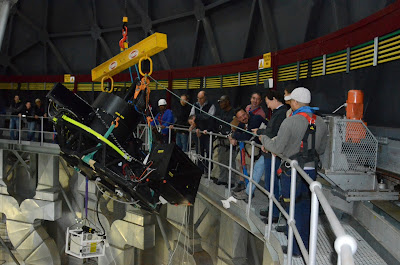What a difference 30 days can make... The RSS was brought down on 1 August, it's been taken apart completely, extensively over-hauled & put back together. So today it was time to get it back on top of the telescope!
 |
| Gone - almost without a trace! |
Looking & working better in every way than it did when it came down, the spectrograph was wheeled out into the loading bay outside the spectrometer room.
 |
| The lifting team getting everything set up |
With RSS rigged up, released from the support frame & ready to ascend through the hatch in the floor, it was project leader (& very happy, but still anxious!) Ockert's cue to fire up the inspirational soundtrack :)
 |
| Cue the music! |
The crafty scheme to pull back a day & thus restore the schedule was to lift the instrument with the detector cold. That required keeping the cryo-cooler attached & running throughout most of the lift & installation. It added a bit more complexity to an already daunting procedure, but it worked a treat as it allowed us to get on sky as soon as all of the cabling/fibres/hoses etc had been reconnected up there.
 |
| Cryotiger in tow this time! |
An enthusiastic crowd was in place to take a last look as the spectrograph (& cryo-cooler!) paraded past the catwalk...
 |
| Quite a crowd gathered for the occasion |
The structure was then rotated into place (by Ant down in the control room) & then with the landing zone within reach, the compressor was disconnected & taken back down to its igloo.
 |
| Time to disconnect the cryo-cooler |
Dome crane operator Denville could then tweak the dome rotation & lower the RSS towards the tracker, to be guided down carefully by the many hands below.
 |
| Being helped along for a smooth landing on the tracker |
Timmy & Jono, perched on the edge of the world, could later crank down the chain hoists to slacken the lifting slings.
 |
| Try not to think about where Timmy was actually standing! |
With all the life-support systems connected up top, the control room filled up as Fred did a coarse mirror alignment (a fine alignment was out of the question due to the high the wind).
 |
| Waiting to see whether the telescope really is back together again |
The first pointing was to a spectacular target - M16, also known as the Eagle Nebula, a star-forming region in the constellation Serpens. As usual, a picture was worth at least a thousand words! It immediately showed that the telescope pointing's good, the image quality looks fine (given that we could not do a fine alignment of the primary because of the wind), even the guide probe mapping was still close enough to find a guide star.
 |
| 2 sec SALTICAM image of the Eagle Nebula! |
Retracting the SALTICAM fold mirror in the payload then allowed the light to reach the RSS & that image looked great too...
 |
| 20 sec H-alpha image taken with RSS |
A quick (5 sec) spectrum of a bright star in the field confirmed that the slitmask, grating & filter mechanisms are all working as they should too :) There's plenty more testing & on-sky performance verification to be done, so now it's mostly over to Astro Ops to put everything through its paces & check that all's well before getting back to full science operations in a few days time (weather permitting)...
 |
| We've blasted through August, so now it's getting Springy in Suthers |
It's been an incredibly busy month up here. Huge thanks & congratulations are in order for a superb team effort, & particularly to Ockert for doing a fantastic job of organising & leading such a challenging project! We eag(er)ly await a photometric night to take throughput measurements!
 |
| Watch this space! |









































